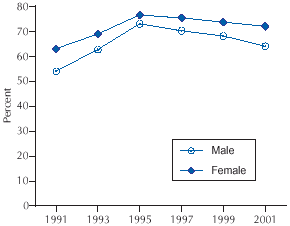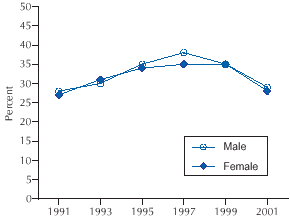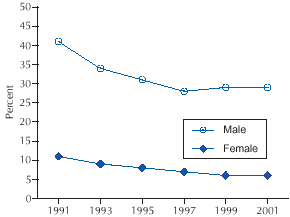
|

|

Using YRBSS Data
State and local health and education officials use YRBSS data in a
variety of ways:
CDC’s Leadership Role
To ensure the availability of accurate and current information on
health risk behaviors among young people, CDC provides funding and
technical support to states and major cities to conduct a Youth Risk
Behavior Survey (YRBS). In addition, CDC supports coordinated school
health programs in a number of states to provide young people with the
information and skills they need to avoid unhealthy behaviors.
Assisting With State and Local Surveys
With technical assistance from CDC, state and local departments of
education and health conduct a YRBS every 2 years. Sites can add or
delete questions in the core questionnaire to better meet the interests
and needs of the state or major city. School-based surveys were last
conducted and analyzed in 2001 among students in grades 9–12 in 38
states and 19 major cities. The average sample size of the surveys was
1,819 students.
CDC’s technical assistance includes
- Training for state and local coordinators.
- Sample selection and data processing.
- Help with applying survey results to improve school health
programs and policies.
Conducting National Surveys
In addition to assisting states, CDC conducts a national survey every
2 years to produce data representative of students in grades 9–12 in
public and private schools in the 50 states and the District of
Columbia. The 2001 survey had more than 13,000 respondents.
To provide critical information on health risk behaviors among young
people in high-risk situations and those in colleges, CDC conducted
additional national surveys:
- The National Alternative High School Youth Risk Behavior Survey,
conducted in 1998 among a representative sample of almost 9,000
students in alternative schools.
- The National College Health Risk Behavior Survey, conducted in
1995 among a representative sample of about 5,000 undergraduate
students. CDC hopes to conduct another survey in 2005.
Results From National Surveys, 1991–2001
Percentage of High School Students
Who Did Not Attend Physical Education
Classes Daily

Percentage of High School Students
Who Smoked a
Cigarette in the Past Month

Percentage of High School Students
Who Carried a
Weapon in the Past Month

Source: CDC, Youth Risk Behavior Survey, 1991–2001.
YRBSS Participants and Uses
|
Participants in the 2001 YRBSS |
|
These sites conducted their own surveys. |
|
States |
Alabama
Arkansas
Colorado
Delaware
Florida
Georgia
Hawaii
Idaho
Illinois
Indiana
Iowa
Kansas
Kentucky |
Louisiana
Maine
Massachusetts
Michigan
Mississippi
Missouri
Montana
Nebraska
Nevada
New Hampshire
New Jersey
New York
North Carolina |
North Dakota
Oregon
Rhode Island
South Carolina
South Dakota
Tennessee
Texas
Utah
Vermont
West Virginia
Wisconsin
Wyoming |
|
Cities |
Baltimore
Boston
Chicago
Dallas
Detroit
District of Columbia |
Fort Lauderdale
Houston
Los Angeles
Miami
Milwaukee
New Orleans |
New York City
Orlando
Palm Beach
Philadelphia
San Bernardino
San Diego
San Francisco |
|
Purposes of the YRBSS
- Determine the prevalence of health risk behaviors.
- Assess whether health risk behaviors increase, decrease, or remain
the same over time.
- Examine the co-occurrence of health risk behaviors among young
people.
- Provide comparable national, state, and local data.
- Monitor progress toward achieving the Healthy People 2010
objectives, which are based on the 10 leading health indicators.
Access YRBSS Data Using Youth 2001 Online
Youth 2001 Online is a useful new tool now available at the YRBSS Web
site (www.cdc.gov/yrbss). Youth
2001 Online contains results for national, state, territorial, and local
surveys conducted from 1991 through 2001. Youth 2001 Online allows
people to
- Create tables and graphs showing survey results.
- See results from national, state, local, and territorial surveys.
- Explore results by race/ethnicity, sex, or school grade.
- Compare survey results for two locations or survey years.
- Create reports that show which behaviors have changed
significantly over time.
Future Directions
CDC will continue to help states and cities gather the data they need
to monitor young people’s health-related behaviors and strengthen
programs to promote lifelong healthy choices among youth. In addition,
CDC will find new ways to help education and health professionals
analyze and use YRBSS data and maximize the data’s effectiveness in
improving
school health policies and programs.
For more information or additional copies of this document, please
contact the
Centers for Disease Control and Prevention
National Center for Chronic Disease Prevention
and Health Promotion
Mail Stop K–32
4770 Buford Highway, NE
Atlanta, GA 30341-3717
(888) 231-6405
ccdinfo@cdc.gov
http://www.cdc.gov/YRBSS/
|
|
